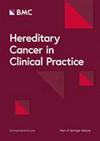Delineating the role of osteoprotegerin as a marker of breast cancer risk among women with a BRCA1 mutation
IF 2.4
4区 医学
Q3 ONCOLOGY
引用次数: 3
Abstract
Women with a pathogenic germline mutation in the BRCA1 gene face a very high lifetime risk of developing breast cancer, estimated at 72% by age 80. Prophylactic bilateral mastectomy is the only effective way to lower their risk; however, most women with a mutation opt for intensive screening with annual MRI and mammography. Given that the BRCA1 gene was identified over 20 years ago, there is a need to identify a novel non-surgical approach to hereditary breast cancer prevention. Here, we provide a review of the emerging preclinical and epidemiologic evidence implicating the dysregulation of progesterone-mediated receptor activator of nuclear factor κB (RANK) signaling in the pathogenesis of BRCA1-associated breast cancer. Experimental studies have demonstrated that RANK inhibition suppresses Brca1-mammary tumorigenesis, suggesting a potential target for prevention. Data from studies conducted among women with a BRCA1 mutation further support this pathway in BRCA1-associated breast cancer development. Progesterone-containing (but not estrogen-alone) hormone replacement therapy is associated with an increased risk of breast cancer in women with a BRCA1 mutation. Furthermore, BRCA1 mutation carriers have significantly lower levels of circulating osteoprotegerin (OPG), the decoy receptor for RANK-ligand (RANKL) and thus endogenous inhibitor of RANK signaling. OPG levels may be associated with the risk of disease, suggesting a role of this protein as a potential biomarker of breast cancer risk. This may improve upon current risk prediction models, stratifying women at the highest risk of developing the disease, and further identify those who may be targets for anti-RANKL chemoprevention. Collectively, the evidence supports therapeutic inhibition of the RANK pathway for the primary prevention of BRCA1-associated breast cancer, which may generate unique prevention strategies (without prophylactic surgery) and enhance quality of life.描述骨保护素作为BRCA1突变女性乳腺癌风险标记物的作用
携带BRCA1基因致病种系突变的女性一生中患乳腺癌的风险非常高,到80岁时患乳腺癌的风险估计为72%。预防性双侧乳房切除术是降低风险的唯一有效途径;然而,大多数携带突变基因的女性选择每年进行核磁共振成像和乳房x光检查。鉴于BRCA1基因早在20多年前就被发现,有必要确定一种新的非手术方法来预防遗传性乳腺癌。在这里,我们提供了新的临床前和流行病学证据,提示孕激素介导的核因子κB受体激活因子(RANK)信号通路失调在brca1相关乳腺癌的发病机制中。实验研究表明,RANK抑制可以抑制brca1 -乳腺肿瘤的发生,这提示了预防brca1的潜在靶点。在携带BRCA1突变的女性中进行的研究数据进一步支持了这一途径在BRCA1相关乳腺癌发展中的作用。含有黄体酮(但不单独含有雌激素)的激素替代疗法与BRCA1突变女性患乳腺癌的风险增加有关。此外,BRCA1突变携带者的循环骨保护素(OPG)水平显著降低,OPG是RANK配体的诱饵受体(RANKL),因此是RANK信号的内源性抑制剂。OPG水平可能与疾病风险相关,表明该蛋白作为乳腺癌风险的潜在生物标志物的作用。这可能会改进目前的风险预测模型,对患病风险最高的妇女进行分层,并进一步确定那些可能成为抗rankl化学预防目标的妇女。总的来说,这些证据支持通过抑制RANK通路对brca1相关乳腺癌进行一级预防,这可能产生独特的预防策略(无需预防性手术)并提高生活质量。
本文章由计算机程序翻译,如有差异,请以英文原文为准。
求助全文
约1分钟内获得全文
求助全文
来源期刊
CiteScore
3.10
自引率
5.90%
发文量
38
审稿时长
>12 weeks
期刊介绍:
Hereditary Cancer in Clinical Practice is an open access journal that publishes articles of interest for the cancer genetics community and serves as a discussion forum for the development appropriate healthcare strategies.
Cancer genetics encompasses a wide variety of disciplines and knowledge in the field is rapidly growing, especially as the amount of information linking genetic differences to inherited cancer predispositions continues expanding. With the increased knowledge of genetic variability and how this relates to cancer risk there is a growing demand not only to disseminate this information into clinical practice but also to enable competent debate concerning how such information is managed and what it implies for patient care.
Topics covered by the journal include but are not limited to:
Original research articles on any aspect of inherited predispositions to cancer.
Reviews of inherited cancer predispositions.
Application of molecular and cytogenetic analysis to clinical decision making.
Clinical aspects of the management of hereditary cancers.
Genetic counselling issues associated with cancer genetics.
The role of registries in improving health care of patients with an inherited predisposition to cancer.

 求助内容:
求助内容: 应助结果提醒方式:
应助结果提醒方式:


